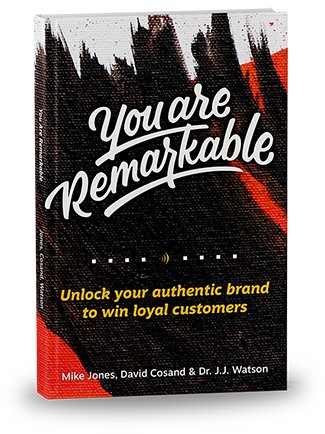 “Why do I have a website?”
“Why do I have a website?”
Have you ever stopped to ask yourself that question? Is it just so you can show up somewhere online? Is it so that customers can get to know you before they hire you? Is it so you can talk about your huge vision for bettering the world? Is it so people can download your ebook?
All of these are valid answers, but the important thing is that you know what you’re trying to say, and why you’re trying to say it. That’s called content strategy, and if you don’t have one, your website probably won’t fare well.
Last week we talked about The 11 Design Don’ts for 2017 Website. Now, let’s talk content. Here are nine things you DON’T want to do.
1. Just wing it.
Before designing (or even writing content) for any page on your website, have a clear and defined goal for a specific segment of your audience. If you don’t, you’ll wind up trying to design the page for everyone…which usually looks like a buffet table after the party – a massive, chaotic mess with no clear messaging. Let’s make this simple:
No clear messaging = no clear calls-to-action.
No clear calls-to-action = no sale.
Pretty simple, huh?
2. Cram your site with keywords because that totally works.
*insert eye roll*
So everyone wants to rank well on Google and other search engines with their content. I get that. But if you think that stuffing a bunch of keywords and phrases into every page on your site is going to help, you should probably brush up on your SEO (search engine optimization) knowledge.
Not only will keyword stuffing not help you rank better (and it may actually be detrimental to your search engine rankings), but it will also confuse and frustrate people on your website.
Remember…people (not search bots) are the reason you have this website in the first place.
Best practice: research keywords that people in your target audience use to search for products and services like yours. Use those keywords to help you build a content strategy for your website and blog. Then write the best damn content you can for those human beings. They’ll love it. Google bots will love it. Everyone wins.
3. Care more about the style than the content.
I can’t tell you how many websites I’ve seen that clearly had a talented designer involved but the writing was a complete after-thought. If you really want your website to perform, invest in a designer AND a copywriter. You’ll find that not only is your website beautiful, easy to use, and well laid out, but the messaging actually draws people in and compels them to take action. No amount of ‘pixel pushing’ or ‘design magic’ will make up for unclear content full of industry jargon.
4. Have a presumptuous or manipulative sales track that doesn’t allow your audience to find the information they’re actually looking for.
Even if you get rid of annoying ads and flash banners, your content and flow can still be incredibly “salesy”. Remember that you have only a top-level idea of why people are on your site, and you shouldn’t cram everyone into one sales funnel.
There’s nothing more annoying than sentences like, “We know you’re looking for the best daycare in the state.”, when you’re actually on the website to create a partnership or pitch educational materials. Or, maybe you’re just doing research and don’t even have kids.
How presumptuous.
5. Assume your website visitors are experienced with your business and products.
This is just good manners. When you’re an engineer talking to a landscaper at your local networking event, you’re not going to assume that he knows all about fluvial geomorphology. He’s also not going to assume that you’re well-versed in the differences between Trailing Acacia and Trailing Dalea plants.
Why, oh why, do we think it’s ok to do anything different on our websites?
Look, you know your particular business far, far better than your customers (or at least we would hope so). And with your expertise, there can be a thousand assumptions made when writing your website content. This often turns into a hierarchy of pages and content that reflect the way you think about your business and products but not how your customers think about them.
- Question every page title, every headline, every paragraph.
- Ask yourself – if I knew nothing about my industry or products or how my business operates, would I understand this content and flow?
- Run it by your mom (if she doesn’t work in your industry).
6. Refuse to get a personality.
Buzzwords are ew. Jargon is ew. Legalese is ew.

These are tell-tale signs that your content isn’t original and doesn’t have the end user in mind.
As you write consider these two fundamentals: your specific, target audience and your unique, authentic brand. Your content and the words you use should meld these two things together.
For the love of Seth Godin, don’t be afraid to add some personality! ‘Buttoned’up’ and ‘professional’ will not help you to stand out and differentiate from your competitors. If you’re a small business, let your own personal character come out in your content! If you’re larger, do some homework and establish some guidelines for the personality of the brand. And then infuse these throughout all your content.
Make a joke…it’s ok, trust me.
7. Assume your website visitors are all one specific type of person in a specific mood.
Are you a robot, with one set of interests, experiences, and moods that never change?
Nope. And neither are your customers.
In fact, your potential customers have many different backgrounds, experiences, value-systems, and interests. They’ll also have different moods throughout a single day. To write your website for only one kind of person in one kind of mood is to leave a whole lot of people out of the loop.
Instead, break down your audience into like-minded segments. Also, consider the different moods and goals that people in these segments go through as they continue down their particular ‘buyer journey’ towards a sale. Someone in the early research phase may not be in the mood for sales-heavy language – but someone who’s further down the path may really want to see some good data on how your product or service has performed for people like them.
Customer journeys are critical to writing content for your website that will attract, engage, and even convert them into life-long customers.
8. Not providing any proof, social or otherwise, for the claims that you make. (Or not citing the proof you do have)
Customer testimonials. Case studies with real results. Quotes and statistics from experts. Product reviews. Employee quotes.
We human beings are incredibly social. We highly value the opinions and thoughts of our peers, often going to them first for referrals for products and services. As people come to your website and evaluate you, having this social proof is critical.
And we shouldn’t have to say this, but let’s go back to high school where you got dinged for improperly citing your sources. News flash: Nothing has changed. Now, maybe you don’t have to use the exact MLA or APA style guide, but at least include hyperlinks to where you’re getting information. And take a second to find out where that statistic came from before you boldly display it on your homepage. It’s not legitimate just because someone else pulled it out of nowhere and published it in a blog post.
9. Use a Three. Word. Tagline.
Because, just don’t.
And especially three consecutive buzzwords…..
Specialization. Optimization. Trust.
Get a personality. Be a little more creative…please. We get it, you’re cool and punchy…except…so is everyone else. Be unique with your headlines and stick to words that your users can sink their teeth into. (Yes, this requires some strategy – God forbid you’d have to work on a plan before you just knock out some content…)
And with that, we wrap up Chapter 2 of Website No-No’s. We’ll be back next time with some critical web development no-no’s for your website redesign.
I hope these tips inspire you with your website redesign. If you end up using any of these tips to make your website better, please let us know! Drop us a line in the comments or contact us directly.


